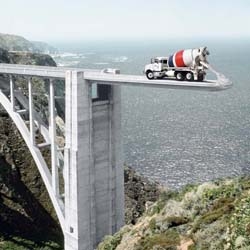Main menu
You are here
Smart Concrete - New Technology
Smart Concrete

The Need
Concrete has been widely used for many years as a composite material for various types of structures. One of the weakness of concrete is that it cannot withstand tension which can cause cracks easily. There has been a huge demand to monitor concrete structures cracking and preventing them from propagating further. These efforts are important for timely repair, safety and long-term durability of critical structures. Non-destructive evaluations, such as attaching or embedding sensors into structures, have been used in many ways to accommodate the demand, yet the tests are considered expensive.
The Technology
Smart concrete was developed Dr. Deborah D.L. Chung from State University of New York at Buffalo. Smart concrete is reinforced by carbon fiber as much as 0.2% to 0.5% of volume to increase its sense ability to strain or stress while still has good mechanical properties.
By adding small amount of short carbon fiber into concrete with a conventional concrete mixer, the electrical resistance of concrete increases in response to strain or stress. As the concrete is deformed or stressed, the contact between the fiber and cement matrix is affected, thereby affecting the volume electrical resistivity of the concrete. Strain is detected through measurement of the electrical resistance. So, the smart concrete has the ability to sense tiny structural flaws before they become significant, which could be used in monitoring the internal condition of structures and following an earthquake.
In addition, the presence of the carbon fibers also controls the cracking so that the cracks do not propagate catastrophically, as in the case of conventional concrete.
Some of the application of smart concrete are:
- The use of smart concrete for the purpose of weighting vehicle on the highway. The highway made by this concrete could be able to determine where each vehicle was, and what its weight and speed were. Vehicles could be weighed while traveling normally on the highway.
- The use of smart concrete for the purpose of weighting vehicle on the highway. The highway made by this concrete could be able to determine where each vehicle was, and what its weight and speed were. Vehicles could be weighed while traveling normally on the highway.
The Benefits
- Even by adding carbon fibers, the extra cost of material will increase about 30%, this expense is still significantly cheaper than attaching or embedding sensors into structures.
- Smart concrete is stronger than conventional concrete by the use of carbon fibers.
- It takes greater force for smart concrete to bend, and it absorbs more energy before fracture.
- Monitoring can be a real-time and continuous effort.
Status
Dr. Deborah Chung has patented this technology and performed several further researches and tests for potential application, such as a lab test of the use of smart concrete for weighing moving vehicles. Several papers regarding this technology have been published in several journals and magazines.
Barriers
Although this technology has been through extensive laboratory testing, it still needs field testing and it is not yet available in the market.
Source : www.engineering.purdue.edu/CEM

